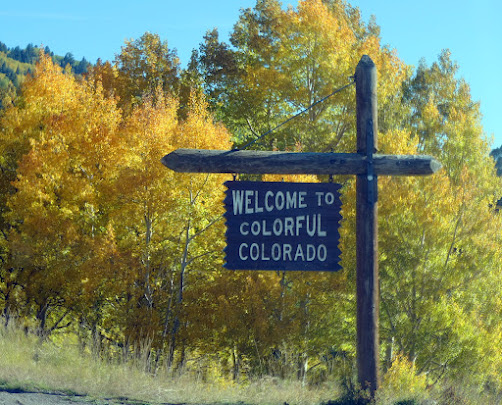Today, I was able to check another item off my bucket list – a ride on the Cumbres & Toltec Scenic Railroad. Even better – a ride during peak fall foliage season! A National Historic Landmark, the Cumbres & Toltec Scenic Railroad is the longest steam railroad in North America, traveling through some of the most spectacular scenery in the Rocky Mountain West. The railroad is owned by the states of New Mexico and Colorado, and it crosses between the two states 11 times.
I had walked over to the station in Chama when I arrived late yesterday afternoon and watched as the train pulled in. Everyone had smiles on their faces as they got off, and I was so excited about my ride today.
 |
| The Station in Chama, New Mexico |
When I booked my ticket, I found one seat remaining in the Parlor car. It seemed to have my name on it. I loved the description that boasted, “Step aboard the Victorian-era elegance of our meticulously restored Parlor cars – a level of luxury, service, and comfort that once was reserved for such dignitaries as railroad barons and mining kings.” That sounded appealing! Even more appealing was the fact that no children were permitted, panoramic windows were operable, a continental breakfast and drinks were provided, and the car was at the end of the train.
I arrived at the Chama station at 8:00 am, not to board the train, but a bus that would take us to Antonito, Colorado. To experience the entire 64-mile railroad line between Chama and Antonito, an hour bus ride was required. We arrived in Antonito and settled into our Parlor car. Coffee was quite welcome by then.
 |
| Boarding the Train in Antonito |
Everyone was excited as we left the station and headed through the flat, open San Luis Valley. The train quickly covered the flat ground and began to climb a series of hills, winding around wide curves and going up into the mountains. We soon began to see aspen trees, many of which had already turned yellow, gold, and orange, and I loved the contrast with the deep green evergreens.
 |
| And, We're Off! |
 |
| It Didn't Take Long Before We Started Seeing the Brilliant Colors of Autumn |
We made a quick stop in Sublette, New Mexico, an abandoned railroad town that still provides water for the steam locomotives. The distant views were spectacular as we made our way along the rim of Toltec Gorge. We went through Mud Tunnel, which is supported by wood beams, then through Rock Tunnel, and then we began to follow the Rio de los Pinos.
 |
| A Safety Check in Sublette |
 |
| Along the Spectacular Toltec Gorge |
 |
| Through the Tunnels |
We stopped for delicious lunch at the old townsite of Osier, Colorado. Past Osier, we crossed the 137-foot-tall Cascade Creek Trestle, the highest on the line. Trees were sparse here, but the open mountain scenery was magnificent.
 |
| Ophir, the Cascade Creek Trestle, and Beautiful Mountain Scenery |
We stopped at Los Pinos to take on water in preparation for the steep climb toward Cumbres Pass. At 10,015 feet in elevation, it is the highest pass reached by rail in the United States. We crossed State Highway 17, and the cars had to wait for us to pass. At the summit is a historic section house and car inspector’s house, and we stopped here for a safety check.
 |
| Los Pinos to Cumbres Pass |
As we began our steep descent, we were once again surrounded by glorious aspen trees on our way to lower elevations. The Chama Valley provided more wide-open vistas, and we began to see signs of “civilization. After crossing the Lobato Trestle, which spans Wolf Creek, we pulled into Chama, the end of the rail. What a ride!
 |
| More Glorious Aspen |
 |
| The Chama Valley, Lobato Trestle, and Back in Chama |
The ride was everything I imagined and more, and I couldn’t have picked a better time to enjoy the golden aspen. The parlor car was also worth every penny. Not only were the other passengers friendly and the drinks and snacks welcome, but the access to the rear platform of our car provided unobstructed views of the breathtaking scenery.
I crossed the street to my hotel, which, unfortunately, turned out to be not one of my better choices. Yes, it was a historic hotel, and the room was mostly clean, but it was more old than historic. Food at the restaurant downstairs was good, however, and the location was perfect for a walk to the station.
 |
| The Chama Hotel and Shops |


















































